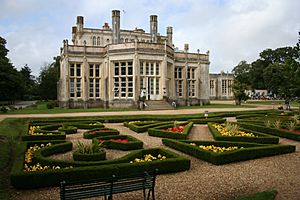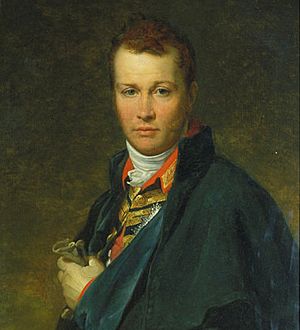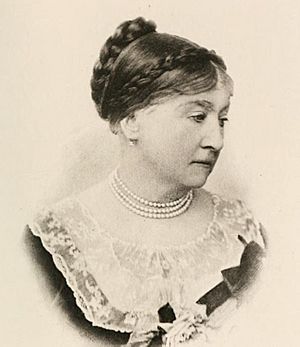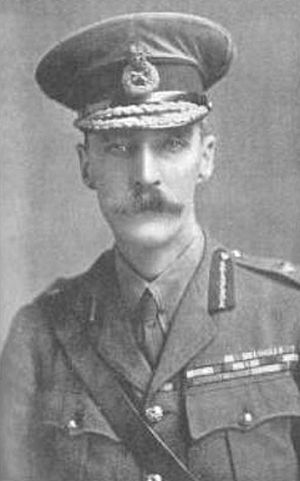Highcliffe Castle facts for kids
Quick facts for kids Highcliffe Castle |
|
|---|---|
 |
|
| General information | |
| Architectural style | Georgian Gothic Revival |
| Town or city | Highcliffe, Dorset |
| Country | England |
| Construction started | 1830 |
| Renovated | 1977 onwards |
| Client | Charles Stuart, 1st Baron Stuart de Rothesay |
| Owner | Christchurch Council |
| Design and construction | |
| Architect | William Donthorne |
| Renovating team | |
| Architect | Niall Phillips Architects, Bristol |
|
Listed Building – Grade I
|
|
| Official name: Highcliffe Castle | |
| Designated: | 14 October 1953 |
| Reference #: | 1110077 |
Highcliffe Castle is a beautiful old building located on the cliffs in Highcliffe, Dorset, England. It was built between 1831 and 1835 for Charles Stuart, 1st Baron Stuart de Rothesay. The castle has a special Gothic Revival style, which looks like old medieval castles.
What makes Highcliffe Castle unique is that it uses many carved stone pieces from old ruined buildings in France. These pieces came from the Benedictine Abbey of St Peter at Jumieges and the Grand' Maison des Andelys in Normandy. Today, Highcliffe Castle is a very important historic building. It is owned by the Christchurch, Dorset Council and is open for people to visit.
Contents
What does the Latin inscription mean?
On the outside of the castle, above the main part, you can see a Latin quote. It says: Suave mari magno turbantibus aequora ventis e terra magnum alterius spectare laborem. This means: "It is pleasant, when a great sea is stormy, to watch from the shore someone else's great struggle."
This quote comes from an ancient Roman poem. It suggests that it's nice to be safe and watch others deal with their problems.
History of Highcliffe Castle
The land where Highcliffe Castle stands today was once part of a larger estate. An earlier house, High Cliff House, was on the site. Later, Charles Stuart, 1st Baron Stuart de Rothesay, decided to buy back his family's land. He wanted to build a grand new home there.
Lord Stuart de Rothesay: The Builder
Charles Stuart was born in 1779. He became a diplomat, which means he worked for his country in other nations. He served in places like Vienna, St Petersburg, and France. He was very important during the time of Napoleon's Hundred Days and the Battle of Waterloo. After Napoleon's defeat, Charles helped the French King return to Paris.
He married Lady Elizabeth Yorke, who was very wealthy. They had two daughters, Charlotte and Louisa. Charles's biggest success was helping Brazil become independent from Portugal in 1825. In 1828, he was given the title Baron Stuart de Rothesay.
After retiring, Lord Stuart began building Highcliffe Castle in 1830. The architect, William Donthorne, designed the castle. It was built to have great views of The Needles and the Isle of Wight. As mentioned, parts of the castle were built using old stone from French ruins. These ruins were damaged after the French Revolution. The castle also includes an old window from the 1500s and a beautiful stained glass window.
Charles became an ambassador to Russia in 1841. However, he became ill and returned to England. He passed away at Highcliffe in 1845. He is buried nearby at St Mark's Church.
Louisa, Marchioness of Waterford: An Artist's Home
After Charles Stuart's death, his wife Lady Elizabeth inherited the castle. When she passed away in 1867, the castle went to their younger daughter, Louisa. Louisa was born in Paris in 1818. She lived at Highcliffe Castle from 1834 and also had a home in London.
In 1842, Louisa married Henry, Marquis of Waterford. She became the Marchioness of Waterford. Louisa was a very talented painter. Her artwork is still admired today. After her husband died in 1859, she moved to Ford, Northumberland. There, she built a school hall and painted Bible scenes on its walls. These paintings can still be seen today in Lady Waterford Hall.
Louisa inherited Highcliffe Castle in 1867. She spent her summers there and her winters at Ford Castle. She often had many guests at Highcliffe. One of her friends, Augustus Hare, described a typical day. Guests would enjoy breakfast, read newspapers, and then gather in the library. Louisa would paint while someone read aloud. After lunch, they would often walk on the beach.
Louisa even entertained the Prince and Princess of Wales at the castle. They later became King Edward and Queen Alexandra. She wrote about one visit in 1880. The royal family landed on the beach, came up for tea, and enjoyed the shore. The young princes even swam in the sea.
Louisa passed away in 1891. Since she had no children, she left Highcliffe Castle to a distant cousin, Edward Stuart Wortley.
Edward Stuart Wortley: A Military Man
Edward James Stuart Wortley was born in 1857. He joined the Army in 1877. He was a brave soldier and fought in several battles in Africa. In 1901, he worked as a military expert in Paris for three years. He was promoted to Major General in 1913.
In 1907, a very famous guest stayed at Highcliffe Castle for three weeks. This was Kaiser Wilhelm II, the German Emperor. He visited to rest and recover his health. The Kaiser gave two stained glass windows to Stuart Wortley, which were placed in the castle.
Edward Stuart Wortley's wife, Violet Stuart Wortley, lived at Highcliffe Castle for a long time. She was born in 1866 and married Edward in 1891. They had three children. Violet was a writer and wrote a book about the Stuart family. She sold Highcliffe Castle in 1949.
Harry Gordon Selfridge: The Retail Pioneer
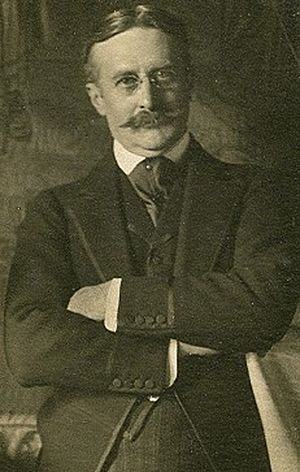
While the Stuart Wortleys owned the castle, it was sometimes rented out. A famous tenant from 1916 to 1922 was Harry Gordon Selfridge. He was an American businessman who created the famous Selfridges department store in London. He lived at Highcliffe with his wife, mother, and son.
Harry Selfridge was very successful in retail. He started his own store in London in 1909. It became very popular because he brought new ways of marketing from America.
When he leased Highcliffe Castle, he made many improvements. He added modern bathrooms, central heating, and a new kitchen. During World War I, his wife, Rose, helped the Red Cross. She opened a special camp for American soldiers in the castle grounds. Sadly, Rose passed away in 1918 due to a serious illness. Harry's mother also passed away a few years later. Harry gave up the lease to Highcliffe in 1922. He is buried in St Marks Churchyard in Highcliffe, next to his wife and mother.
Decline and Fires
In the early 1950s, a local businessman bought the castle. He wanted to turn it into a home for children who needed to recover from illness. However, the home later closed due to some problems.
The castle was then sold to a developer. He built new homes on the estate land around the castle. After that, the castle itself was sold to a group of Roman Catholic missionaries. They wanted to use it as a training center for priests. They built a dormitory next to the East Wing, which is now the castle's tearooms. But the costs to keep the castle were too high, so the missionaries moved out in 1966.
In 1967, three local businessmen bought the castle. However, two fires badly damaged the Great Hall and other parts of the castle. The main staircase had to be removed. Because no one could agree on what to do with the castle, it was left open to the weather and vandals. It became a ruin. Many people and historical groups were worried about its future.
Restoration and Present Day
After many discussions, the Christchurch Council bought the castle in 1977. They paid £65,000 for it. The council opened the castle grounds and beach access to the public. This was done to celebrate the Queen's Silver Jubilee.
The council couldn't afford all the repairs needed. In 1989, they worked with English Heritage to plan the castle's future. In 1990, scaffolding and sheeting were put around the castle to protect it. In 1994, the repair work began. The first part fixed the south wing, including the Wintergarden and Library.
The Heritage Lottery Fund helped with funding, providing £2.6 million. This allowed all major repairs to be finished by 1998. The East Tower, which had been taken down in 1974 because it was unsafe, was rebuilt. Skilled craftspeople won an award for their excellent work on the castle.
Today, Highcliffe Castle is a Grade I listed building. This means it is a very important historical site. It is owned by Christchurch Council. The castle is described as "the most important remaining example of the Romantic and Picturesque style of architecture."
The castle is open to the public all year round. It hosts many events and can be used for weddings and other private gatherings. In 2008, major work was done to open more parts of the castle to visitors. This included the dining room and butler's pantry. New public toilets were also built.
More recently, in 2018, another big renovation project took place. This work opened up parts of the castle that had been closed for over 50 years. These areas were damaged by the fires and vandalism in the 1970s. New stairs and a walkway were added, making more of the castle accessible to everyone.


